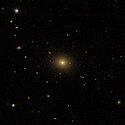NGC 4021
| Galaxie NGC 4021 | |
|---|---|
 | |
| SDSS-Aufnahme | |
| AladinLite | |
| Sternbild | Haar der Berenike |
| Position Äquinoktium: J2000.0, Epoche: J2000.0 | |
| Rektaszension | 11h 59m 02,595s [1] |
| Deklination | +25° 00′ 59,58″ [1] |
| Erscheinungsbild | |
| Morphologischer Typ | E[1] |
| Helligkeit (visuell) | 14,8 mag[2] |
| Helligkeit (B-Band) | 15,8 mag[2] |
| Winkelausdehnung | 0,40′ × 0,3′[2] |
| Positionswinkel | 85°[2] |
| Flächenhelligkeit | 12,6 mag/arcmin²[2] |
| Physikalische Daten | |
| Zugehörigkeit | WBL 368[1] |
| Rotverschiebung | 0.033428 ± 0.000009[1] |
| Radialgeschwindigkeit | (10.021 ± 3) km/s[1] |
| Hubbledistanz H0 = 73 km/(s • Mpc) | (447 ± 31) · 106 Lj (136,9 ± 9,6) Mpc [1] |
| Durchmesser | 50.000 Lj[3] |
| Geschichte | |
| Entdeckung | Johan Dreyer |
| Entdeckungsdatum | 26. April 1878 |
| Katalogbezeichnungen | |
| NGC 4021 • PGC 37730 • CGCG 127-124 • MCG +04-28-112 • 2MASX J11590257+2504596 • GALEXASC J115902.53+250457.9 • NSA 160848 • WISEA J115902.59+250459.5 | |
NGC 4021 ist eine kompakte Elliptische Galaxie vom Hubble-Typ E3 im Sternbild Coma Berenices am Nordsternhimmel. Sie ist schätzungsweise 447 Millionen Lichtjahre von der Milchstraße entfernt und hat einen Durchmesser von etwa 55.000 Lichtjahren.
Im selben Himmelsareal befinden sich u. a. die Galaxien NGC 4011, NGC 4015, NGC 4022, NGC 4023.
Das Objekt wurde am 26. April 1878 von Johan Dreyer entdeckt.[4]
Weblinks
Einzelnachweise
Auf dieser Seite verwendete Medien
Autor/Urheber: Sloan Digital Sky Survey, Lizenz: CC BY 4.0

Angle of view: 4' × 4' (0.3" per pixel), north is up.
Details on the image processing pipeline: https://www.sdss.org/dr14/imaging/jpg-images-on-skyserver/